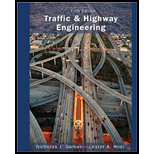
Concept explainers
The difference between short-term and long-term driver expectancy with an example.
Explanation of Solution
Given:
Short-term and long-term driver expectancy.
Drivers depend on their expectations regarding the road layout and road-related examples when driving. Despite data processing and visual inquiry limitations, drivers cope well, even at high speeds, both because roads are generally planned because of driver impediments and because drivers depend on their experience.
Drivers develop both short-term and long-term driver expectancies. Example of short-term expectancies incorporates after going at a moderately fast taking wide distance, that the drivers may expect that the designed ahead road was accommodated to the similar speed.
Example of long-term expectancies incorporate when moving toward convergence, drivers should be in the left path to make a left turn at the crossroad.
Conclusion:
One approach to accommodate for human data processing limitations is to plan roadway conditionsas per driver expectations.
Want to see more full solutions like this?
Chapter 5 Solutions
Traffic and Highway Engineering - With Mindtap
- H.W: The average number of collisions occurring in a week during the summer months at a particular intersection is 2.00. Assume that the requirements of the Poisson distribution are satisfied. 62 Engineering Suatitics Dr. Tarig Hussein 1 Year a) What is the probability of no collisions in any particular week? b) What is the probability that there will be exactly one collision in a week? ) What is the probability of exactly two collisions in a week? d) What is the probability of finding not more than two collisions in a week? ) What s the probability of finding more than two collisions in a week? ) What is the probability of exactly two collisions in a particular two-weck interval? Ans. a) 0.135,b) 0.271, ¢) 0.271, d) 0.677, €) 0.323, ) 0.147arrow_forwardWhich vehicle accidents causes are preventable? Answer using at least 5 sentences and cite your source.arrow_forwardIn your own words, explain Why is it important to know the history of transportation in relation to traffic management? Write in 300 words.arrow_forward
- Incident is an unexpected event that may result in physical harm, death, losses and property damage. Based on your understanding, describe four (4) basic types of incidents with an example.arrow_forwardP4 Compare 'bottom-up and 'top-down' approaches to driving sustainabilityarrow_forwardIn your own words, Explain and Define each term Transportation and Traffic Congestion.Write in 200 words.arrow_forward
- For accident statistics in table below. Comput the following: a) Rates of fatality depending on population b) Rates of PDO accidents depending on registered vehicle Fatalities: Fatal Accidents: Injury Accidents: PDO Accidents: Total Involvements: Vehicle-Miles Traveled: Registered Vehicles: Licensed Drivers: Area Population: 7.5 60 300 2.000 4,100 1.500,000,000 100,000 150.000 300.000arrow_forwardSuppose that a family is leaving on a summer vacation in their camper and that M is the event that they will experience mechanical problems, T is the event that they will receive a ticket for committing a traffic violation, and V is the event that they will arrive at a campsite with no vacancies. Which particular region on the diagram represents the family will experience no mechanical problems and will not receive a ticket for a traffic violation but will arrive at a campsite with no vacancies. M 4 7 1 3 6 8 Varrow_forwardsuppose you are waiting at a corner for a bus, three different routes pass this particular corner. you see buses pass by from the two routes that you are not interested in taking.when you say my bus must be next what type of reasoning deductive or inductive.arrow_forward
- What are the methologies used to research about environmental impacts of public transportations?arrow_forwardIn your own words, you are required to list and define ten (10) terms relating to traffic that you considered the most important and give your insights on why these terms are significant in traffic management.arrow_forwardSubject : Transportation Engineering Give me right solution with clear calculationsarrow_forward
 Traffic and Highway EngineeringCivil EngineeringISBN:9781305156241Author:Garber, Nicholas J.Publisher:Cengage Learning
Traffic and Highway EngineeringCivil EngineeringISBN:9781305156241Author:Garber, Nicholas J.Publisher:Cengage Learning
